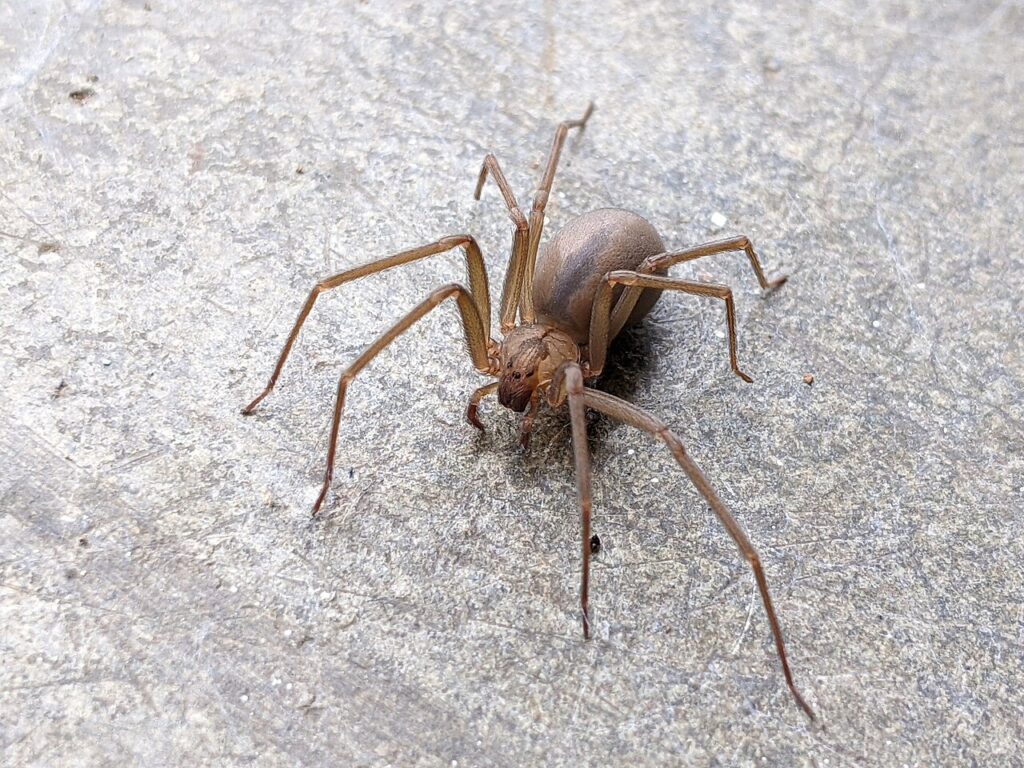
The brown recluse spider (Loxosceles reclusa), is also known as the fiddleback or violin spider due to its distinctive violin-shaped marking on its cephalothorax. This is a small but potentially dangerous arachnid. Typically medium brown in color, this spider measures about 1/2 inch in size, making it comparable to the black widow spider, albeit slightly smaller. A unique feature of the brown recluse is its six eyes, which are arranged in three pairs, unlike most spiders that have eight eyes.
Brown Recluse Habitat and Behavior
Brown recluse spiders prefer secluded environments and often hide in dark, undisturbed areas like basements, attics, and closets. They frequently conceal themselves in boxes, shoes, and other rarely moved household items. Their reclusive nature means they usually avoid human interaction; most bites happen when someone accidentally brushes against them.
These spiders can spread across regions by hitching rides in stored items or transported materials. This adaptability has made them a common pest in many homes throughout the United States, especially in the Midwest and South.
The Dangers of a Brown Recluse Bite
While brown recluse spiders are non-aggressive, their bites can result in serious medical conditions. The venom of a brown recluse is cytotoxic, meaning it can destroy tissue surrounding the bite site. This can lead to symptoms ranging from mild redness and itching to severe pain and necrosis, which is tissue death. It is essential to seek medical attention if bitten, especially if the bite is followed by increasing pain, swelling, or other severe reactions.
First Aid and Treatment
If you suspect a brown recluse bite:
- Clean the area with soap and water to minimize infection risk.
- Apply a cold compress to reduce swelling and pain.
- Seek medical attention, especially if symptoms worsen or you develop systemic symptoms such as fever or chills.
For more detailed first aid check the Red Cross on spider bites.
Prevention and Control
Preventing brown recluse spiders from entering your home involves several strategies:
- Reduce clutter in and around your home, particularly in storage areas. Spiders thrive in dark, cluttered environments.
- Seal cracks and crevices around windows, doors, and foundations to limit entry points.
- Regularly vacuum and dust areas where spiders might hide, including under furniture and in corners.
- Inspect and shake out items such as clothing and shoes that may have been stored for a long time before wearing or using them.
For significant infestations, consider consulting a professional pest control service that can assess the situation and provide appropriate treatments tailored to your home environment.
Conclusion
Understanding the characteristics and behaviors of the brown recluse spider is vital for preventing encounters and mitigating the risks associated with their bites. By taking proactive measures and maintaining cleanliness in your home, you can significantly reduce the likelihood of these spiders becoming a nuisance or a danger to your family. If you have concerns about spiders in your area or suspect an infestation, don’t hesitate to reach out to a pest control professional for assistance.
